Collective Position On Recognizing And Controlling Ground Bearing Pressures For Erecting Tilt-Up Panels
Español | Translation Sponsored by TCA
Position of the Tilt-Up Concrete Association:
The owner’s designated representative for construction shall be responsible for assigning a qualified firm (or firms) to review and confirm that the capacity of the subgrade can safely support the crane’s ground-bearing loads that are provided by the tilt-up erection contractor/crane company.
The preparation of site mobilization and building design often involves a geotechnical engineer determining the suitability of the existing soil conditions, including bearing capacity, soil pressures, and moisture content, as well as the necessary steps for mitigation or adaptation of the building. It is rare during this stage of the design to consider issues of construction means and methods. Therefore, as tilt-up construction projects advance to the erection stage, the maneuvering of large mobile cranes on the jobsite and the standing of often massive concrete panels from the casting position introduce loads far greater than are known or assumed during the design phase. This article provides the reader with important concepts to consider for mitigating risk and ensuring safer construction results when developing a company policy or best practices for the construction sequence. It also serves as a message to the industry regarding responsibility for determining these conditions.
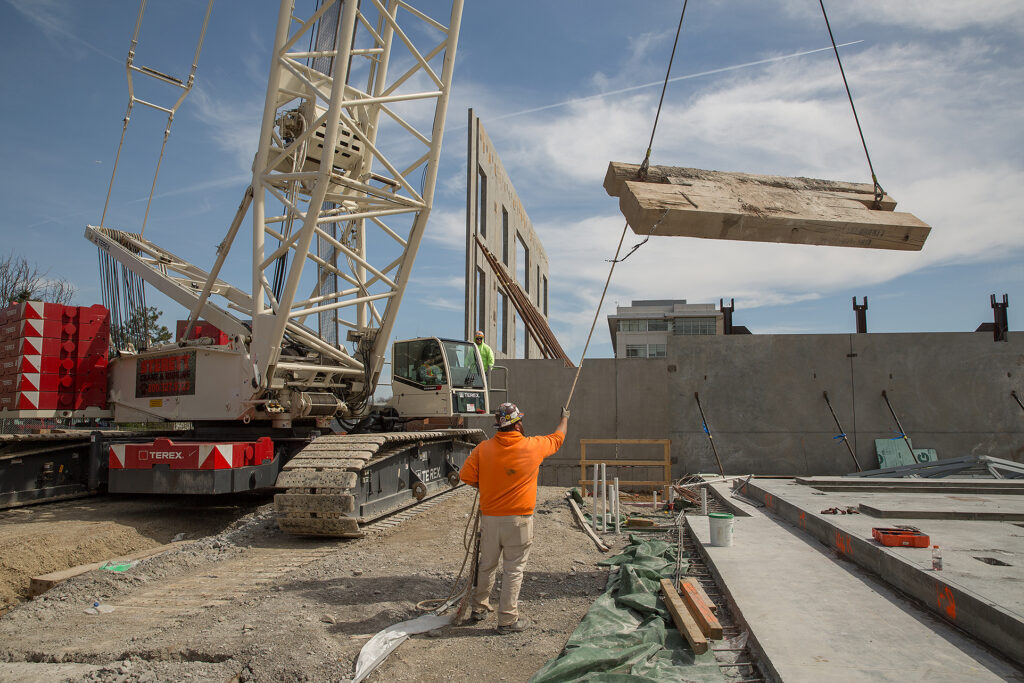
Construction involves a fast-paced environment that requires rigorous attention to planning, investigation, and risk analysis. However, at times, pressure on construction pace, schedule compression, and the volume demanded may force project timelines toward increasingly tighter intervals. As contractors prepare to engage a jobsite and begin the work, one of the greatest risks associated with building construction involving cranes is ignoring or failing to observe and react to changing soil conditions. This is particularly true for the tilt-up construction process where a crane lifts a concrete element from a horizontal plane to a vertical position in the building envelope.
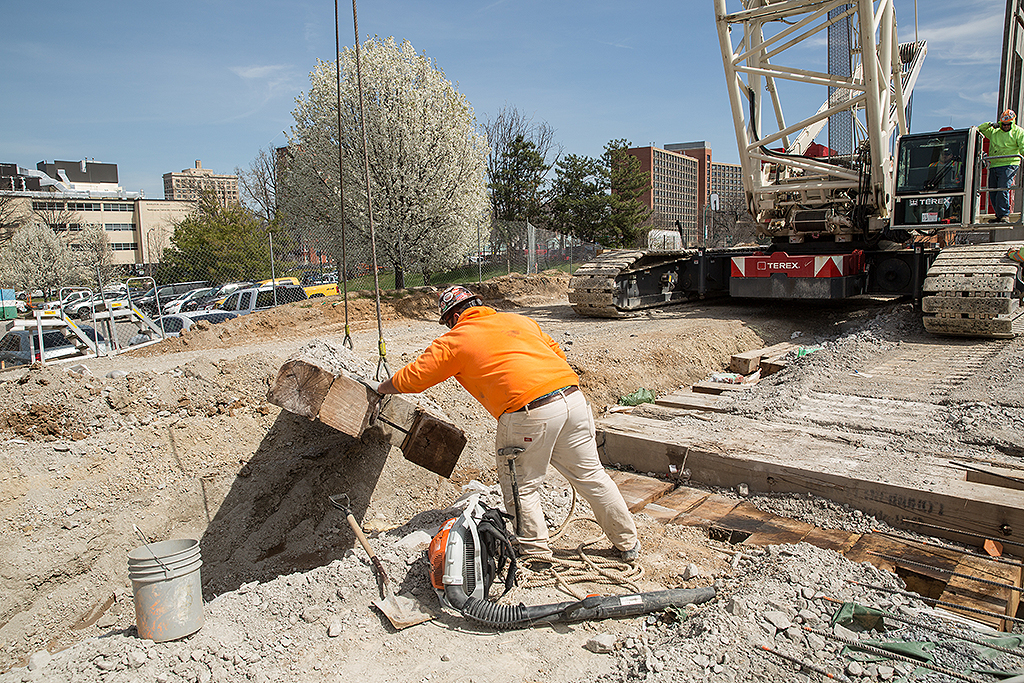
The Occupational Safety and Health Administration (OSHA) issues direction regarding preparation and monitoring of sites in the standard covering cranes and derricks in construction (29 CFR 1926.1402). In item (d) from this standard—assuming the general contractor is the controlling entity or employer, which is normally the case—the cranes standard requires the general contractor to improve the site. OSHA states, “It is ultimately the controlling entity’s responsibility to make sure sufficient improvements to ground conditions are made for the crane to be assembled or used within the requirements of §1926.1402(b).” Furthermore, section 1926.1402(c)(1) requires that the controlling entity must ensure that ground preparations are provided as necessary to meet the requirements in paragraph (b).
The American Society of Mechanical Engineers (ASME) maintains standard B30.5, which is a great reference for any construction professional who wants to understand their responsibilities when it comes to crane safety. In B30.5, the site supervisor holds responsibility for ensuring adequate preparation to any area a crane is to be utilized, including access roads for the crane and associated equipment. Because construction worksite conditions are always subject to change, §1926.1412(d)(1)(x) of OSHA’s cranes standard requires a competent person to inspect the ground conditions each shift to ensure proper support of the crane. In addition, §1926.1402(e) requires that the operator or assembly/disassembly director notify the controlling entity of inadequate ground conditions. Therefore, the site supervisor for the controlling entity, as interpreted by ASME B30.5, must provide for preparations whenever they are needed to address changes in ground conditions that would make its support of the crane inadequate, even if the crane has not moved on the site.
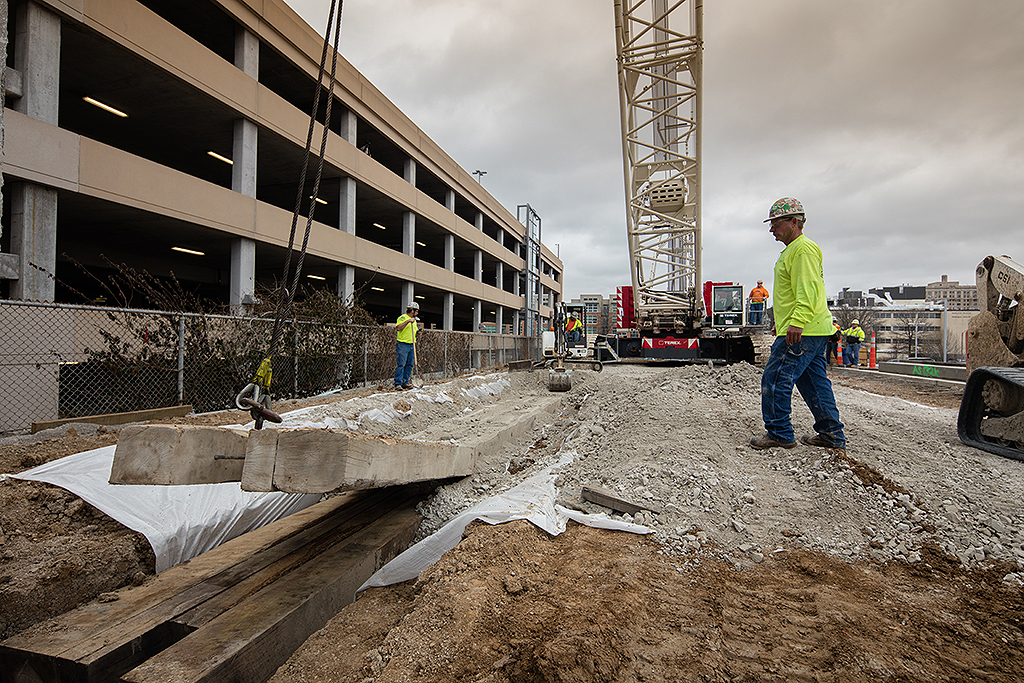
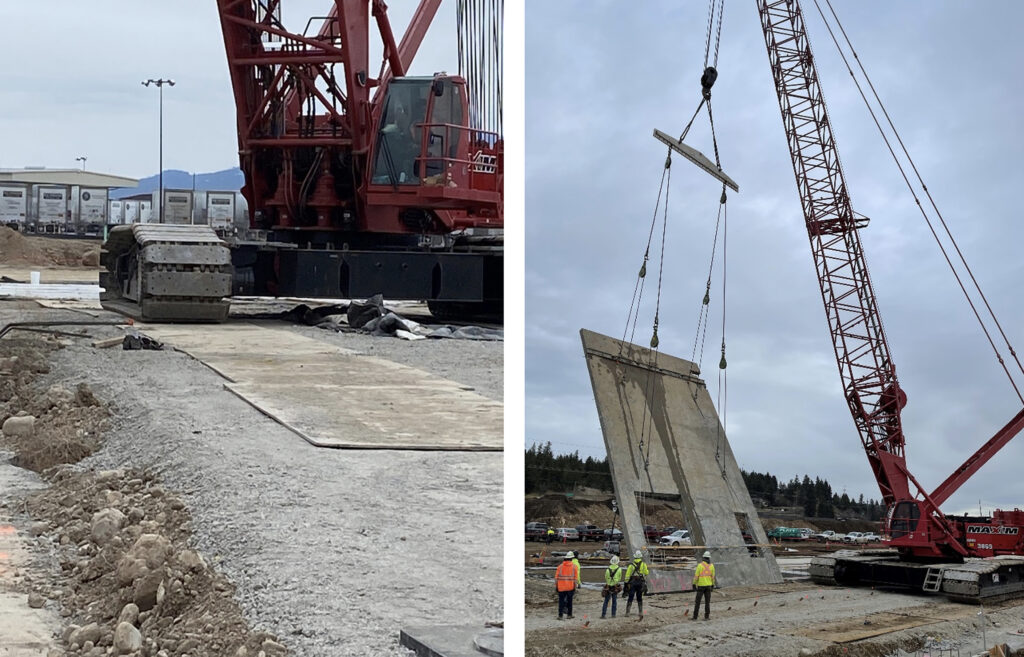
The Current Industry
Tilt-up construction has two approaches regarding how the construction company may position the crane for lifting/erecting the panels. The most common crane position has historically involved placing it on the building’s floor slab (which should have a properly prepared subbase layer) with forces distributed into the concrete by cribbing blocks under the outriggers. This continues to be a common placement selection and is generally one of the first questions answered during the preconstruction planning phase. Utilizing this approach allows for conditions to be controlled and consistent for the crane operator and the panel-erection crew.
During the last two decades, an increasing percentage of projects require or choose to have cranes positioned around the perimeter of the building that is being constructed. This is known as “off-slab erection.” This option may be selected for many reasons, including if the owner expresses concerns regarding slab quality, if the project involves complicated subslab utilities, if the size of the panels demand very large cranes, and/or if the budget requires renting track versus rubber-tired cranes.
Average tilt-up panel sizes and weights have seen significant increases since the 1990s. The Tilt-Up Concrete Association (TCA) and the American Concrete Institute (ACI), in the ACI/TCA Tilt-Up Supervisor Certification program, establish a rule of thumb that three times the weight of the heaviest panel should be considered the crane capacity required. Ever increasing panel sizes and weights require larger cranes to erect tilt-up panels. Likewise, panel heights continue to grow significantly as the method is embraced for a much broader market. This requires greater boom length, which necessitates larger cranes.
As crane sizes increase to lift these larger and taller tilt-up elements, very high ground-bearing pressures result. In most cases across the US, these large cranes will exceed the rated soil capacity safety factors and require some type of ground-bearing pressure subgrade support. In many cases, these ground-bearing pressures are not checked by a qualified firm to verify that crane-access routes can support these ground-bearing loads. While the standards require the controlling entity to be responsible for soil conditions, they are often unknown, requiring communication with and involvement from the tilt-up contractor.
In some of the largest tilt-up markets, like in Texas and California, a third-party erector becomes involved. This further complicates communication and the identification of roles and responsibilities regarding who is to determine both crane size and load as well as the resulting ground pressure. By the time the erector gets on-site, the speed of the schedule and multiple participants sets the stage for unclear communication. Some companies do not check, and in some cases may not know, what the loads are as a panel is moved into position by a crane.
The Process
Initially, the building slab is considered for available and suitable panel erection positioning. This slab is commonly designed by the engineer of record for only the building functions. The floor slab is not likely to be checked for the applied loads of these very large panels and the cranes that are required to lift them.
The general contractor or the tilt-up subcontractor initiates determining the suitability of the floor slab for the operation. The following is a list of items that must be considered:
- Layer Thickness: The structural resistance of the building’s floor slab is a direct function of the designed thickness as well as the type and compaction level of the capillary break aggregate layer that is supporting it. Identifying these variables can determine what additional support is necessary based on the maximum load of the heaviest panel pivoting over one corner of the crane set-up.
- Finished Slab: Understanding the owner’s intent for the building operations and the final appearance of the floor slab will inform the team regarding if precautions are realistic and available to protect the floor while lifting from the building slab.
- Slab Access: The available, or ideal, access point for where the crane should drive onto the building slab must be considered. Identifying the perimeter features of the site, excavations, utilities, and other obstacles may determine if, and to what degree, access to the slab exists for a crane.
- Crane Type: The use of rubber-tired hydraulic cranes and the availability of suitably sized cranes are key factors when determining if the building slab should be used for erecting panels. Although it is possible to protect a slab from a track crane with crane mats, this is often uneconomical or impractical. The availability of crane type in relation to the soil conditions may also direct a preference or necessitate erecting from the building slab as hydraulic cranes are more difficult to maneuver in challenging soil conditions.
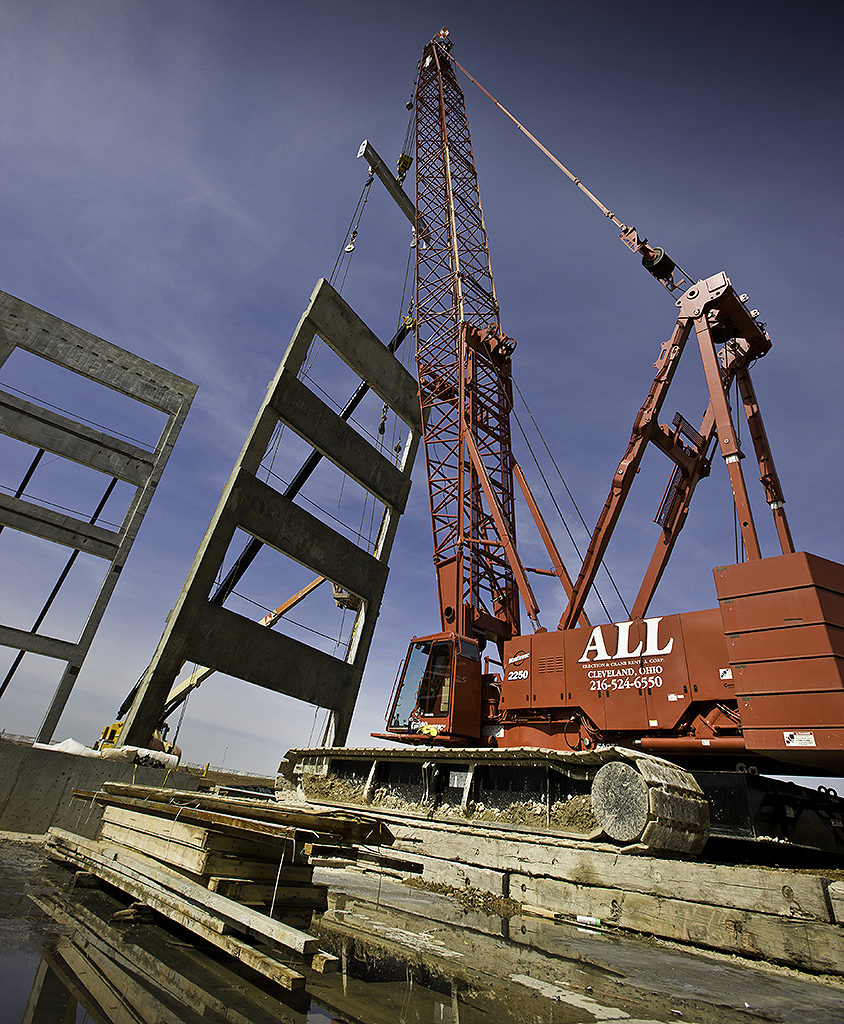
As this list is considered, the alternative to erecting panels with a crane maneuvering around the perimeter of the building slab (known as off-slab erection) may become more appealing. The following should be considered when evaluating this option:
- Ground Conditions: Are there excavations or fill conditions around the building’s perimeter that may have changed the ground conditions substantially since the geotechnical engineer’s evaluation? When consulting the geotechnical engineer’s report, it is important to know whether it remains relevant given the activity that occurred since the initial evaluation.
- Crane Access Route: A crane driving the perimeter of the slab must be located as close as possible to the building slab to preserve maximum crane capacity.
- Changes of Direction: As the crane maneuvers the perimeter of a building slab, will it make abrupt directional changes, and is there adequate space and surface condition to make these changes?
- Location of Panels: The layout of the panels that will be erected is important and should be based on distance of reach and turning to set. It’s critical to ensure that the panels cast on the floor slab are adjacent to the building’s perimeter. In addition, the casting slab paralleling the building floor slab, or the foundation line to receive the panels, must be evaluated for reach and capacity.
Communication
The duty of responsibility is complex and can often be confusing. Determining soil stability and suitability may require different evaluations for the controlling entity, and may or may not involve the tilt-up contractor and the erector. Therefore, some general contractors may be unaware of their responsibilities when it comes to ensuring that the crane road provided to the erection subcontractor must be able to support the load of these larger cranes and tilt-up panels. Communication is critical.
Risk Assessment
In the US, natural soils on most jobsites are rated for an average bearing capacity of 3,000 psf. Assuming a 3:1 safety factor, these soils would begin to fail at 9,000 psf. A 300-ton crawler crane has a generated ground-bearing pressure exceeding 10,000 psf. It is very likely this load will exceed the bearing capacity of the typical soil, which places the construction crew and the project under tremendous risk. Therefore, the crane road will need attention and likely additional support to increase the bearing capacity of the subgrade. This is even before considering that such a crane would lift a panel of up to 200,000 pounds.
Mitigation
There are several ways a contractor working with a geotechnical engineer can augment the bearing capacity of the soil. A geotechnical engineer with the aid of a structural engineer can make a judgement on what needs to be done to a subgrade to support crane ground-bearing loads. This decision should not be undertaken without such consultation. Typical methods include the following:
- cement or lime treatment;
- rocking the subgrade;
- adding wood crane mats; or,
- running the crane on steel road plates.
The TCA continues to work diligently to bring awareness to issues like this through technical resources and key education moments. Placing member resources in front of the general industry and thought leadership at events like the Tilt-Up Convention and Expo gives the platform for these learnings, as well as interactive collaboration.
TCA now offers a position statement, approved by the board of directors, on the observance and engineering for ground-bearing pressures. This document reinforces what OSHA states about the responsibility for verifying crane access capacity and ensuring that the industry is verifying the crane’s ground-bearing pressures prior to the commencement of tilt-up panel erection.
Want to Know More?
Contact TCA Manager for Regulatory and Technical Affairs James Baty at 319-895-6911 or jbaty@tilt-up.org.
The mission of the Tilt-Up Concrete Association is to expand and improve the use of tilt-up as the preferred building system by providing education and resources that enhance quality and performance. More information can be found on the association’s website: www.tilt-up.org.
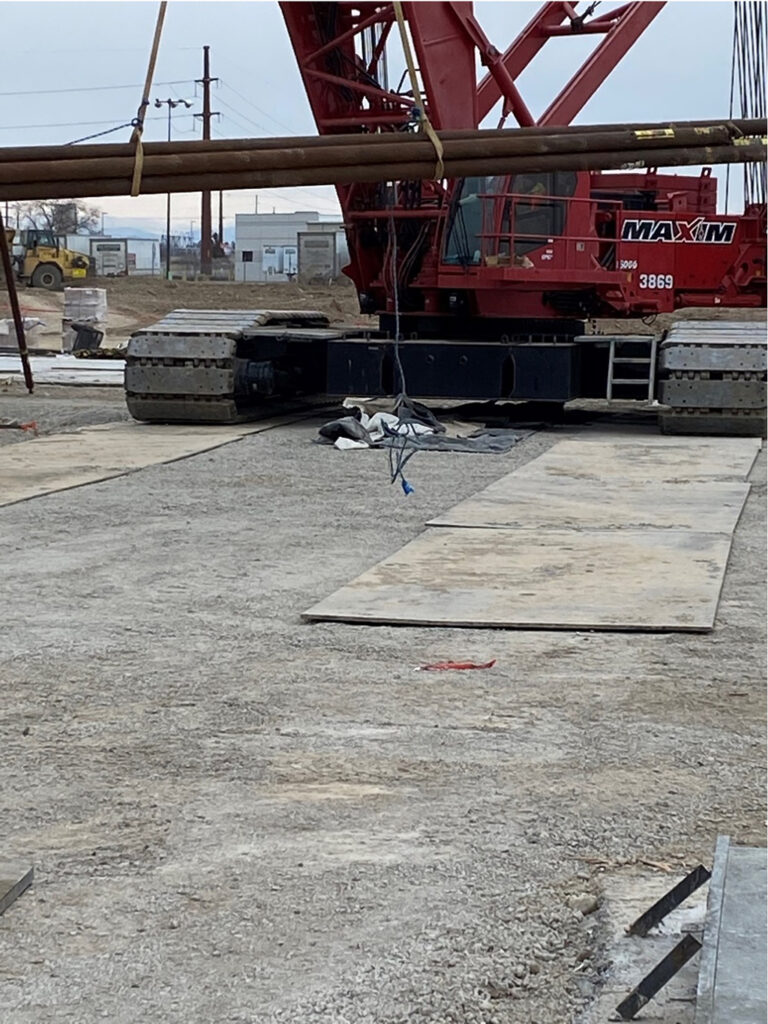
Commentary
Concrete Strategies has been an industry leader in terms of tilt-up safety, educating and engaging the industry and business partners on issues surrounding the review of ground-bearing issues. Barclay Gebel, vice president of tilt-up and precast services for Concrete Strategies, presented on this issue at the 2021 Tilt-Up Convention and Expo in St. Louis. Gebel presented the initial draft of TCA’s statement along with creative ways of safely addressing the issue. Concrete Strategies Safety Director Joe Rock explained that it all starts with planning: “We engage our business partners early on and educate them on things like ground-bearing pressure and the need to have a soils engineer provide guidance and approval for any crane road. We also offer them solutions in terms of means and methods that we have used successfully over the years that may in some cases save our clients thousands of dollars.” One example of the outside-of-the-box solutions presented at the event was the use of steel road plates in lieu of crane mats. “Crane mats are expensive and very difficult to move,” said Rock. “A year or so ago, we came up with the idea of using steel road plates. They are relatively inexpensive compared to wood crane mats, readily available everywhere we build, and easier to move than wood crane mats. We did our homework and engaged some very experienced engineers regarding the use of road plates to provide a safe, efficient, and stable crane road. We’ve used this method numerous times over the last year with great success.”








